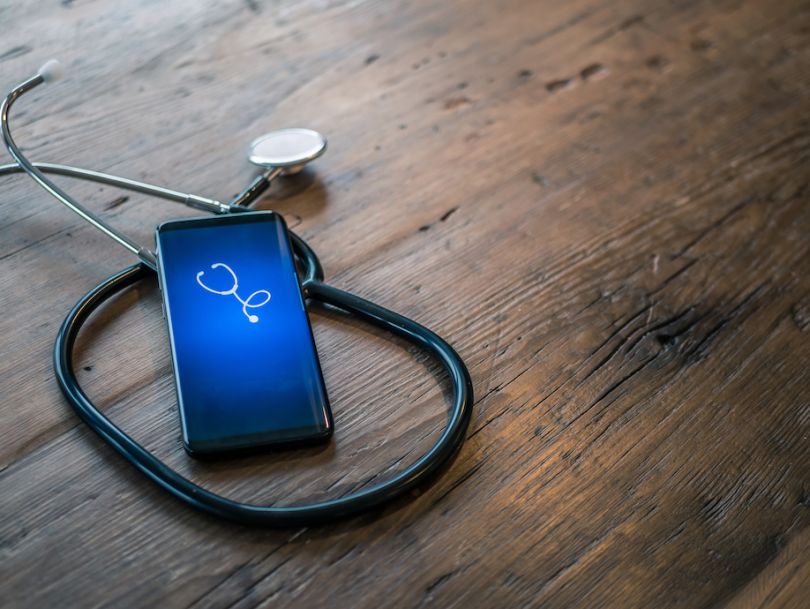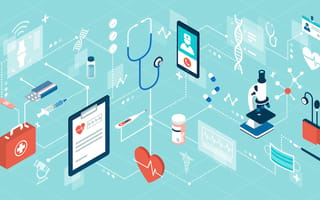The coronavirus is keeping people out of the doctor’s office and on their phones. Social distancing is not conducive to waiting in crowded, potentially contagious, emergency rooms. Enter telehealth: The practice of connecting to health care services through videoconferencing, remote monitoring, electronic consults and wireless communication.
In early March, Congress passed an emergency $8.3 billion measure, easing restrictions on telemedicine’s ability to treat those covered under Medicare, the federal health insurance program for those aged 65 and older. In a meeting with President Donald Trump, private health insurers also said they would pay for virtual doctor’s visits for potential coronavirus patients.
Before the coronavirus, just 6.5 percent of people used telehealth services in 2017, despite health care providers offering the service for at least a decade, according to a study from the Journal of the American Medical Association. Now, telehealth platforms are going viral, presenting technical and business challenges to these providers across the United States.
What is telehealth?

The Coronavirus’ strain on services
Perhaps unsurprisingly, the coronavirus has increased telehealth providers’ traffic and wait times. Talkspace, a New York City-based online therapy app, says it has seen user volume increase 25 percent since mid-February, more than 65 percent year over year, according to a company spokesperson. And “it’s clearly accelerating.” Common questions among users include how to manage their anxiety related to the pandemic, how to talk to their employer about their concerns, the financial impact and more.
It’s not the only platform dealing with increased use.
Total usage of Amwell — a Boston-based telehealth platform used by 2,000 hospitals nationwide — is up 158 percent, Holly Spring, vice president of communications, wrote in an email to Built In. In areas hit particularly hard by the pandemic, use is up even higher. The number of visitors in Washington State, for example, is up 650 percent. Wait times have increased from an average of five minutes to as much as 70 minutes due to the influx of patients trying to be seen virtually.
The platform has not crashed due to the increased number of patients, although Spring said the long wait times — particularly in areas hit hardest by the virus — have caused some patients to think there has been “service crashes” or “waiting room freezes” and voluntarily disconnect. For doctors and hospitals, these disconnects may appear as dropped calls and create the impression that Amwell’s network is down, she added.
To combat the increase in users, Amwell is deploying new servers, routers and other systems to manage the surge in volume and ensure video capacity across telehealth systems, Spring said. The firm is also working to hire and train additional healthcare providers to assist patients on the platform.
“We’re working to stabilize system behaviors in extreme volumes and working to set expectations that patients are likely to experience higher than normal wait times,” Spring said.

Telehealth providers are preparing for supply chain disruption
Davis Liu, chief clinical officer at Lemonaid Health, said he expected Congress’ actions, combined with the economic downturn and consumer dislike for waiting in doctors offices, to drive traffic to the San Francisco-based telehealth provider.
To take advantage of the opportunity, he said engineers at Lemonaid are currently building a coronavirus symptom checker, as well as an “Ask a Doctor” feature, which should be available in less than a month.
“I think we’re going to see more people use us,” Liu said.
Lemonaid connects users with online doctors who specialize in treating anxiety and erectile dysfunction, and in providing birth control medication. Because of this, users’ primary pandemic concern has stemmed from questions about its supply chain — users are worried about a medication shortage, Liu said, since most of the medication in the U.S. is manufactured in China.
About two weeks ago, he ordered an extra two months supply of all drugs Lemonaid doctors prescribe, stocking up on generic Zoloft, Viagra and birth control pills in case the firm’s supply chain gets interrupted.
“Where do we get our meds? What if there’s a backlog? We’re thinking about that second, third and fourth contingencies.”
“Where do we get our meds? What if there’s a backlog? We’re thinking about that second, third and fourth contingencies,” Liu said.
Increasing the supply in medication will also prepare the firm for the influx of patients Liu expects to receive. About two weeks ago, he reflected on the number of companies issuing mandatory quarantines and realized the similarities between now and the economic downturn of 2008.
During that recession, people were laid off from their jobs and lost their health insurance. Liu said he expects a similar situation to occur today — and, when that happens, for consumers to turn to telehealth providers like Lemonaid, since the firm offers low cost doctors visits.
“The speed of how fast the economy crashed, how fast people lost their jobs, they’re going to be looking for an alternative for healthcare,” Liu said.

Providers are building new, COVID-19 features
App downloads of SuperBetter, a Chicago-based app designed to improve users’ mental health, are up 114 percent week over week, according to CEO Keith Wakeman. He added that there has also been a 39 percent increase in the number of users sessions with SuperBetter across the globe.
So far, the app has been able to handle the uptick in users, Wakeman said, and he anticipated even more traffic to the site going forward, due to pandemic-related anxiety and the impact COVID-19 would have on the economy.
Before the Coronavirus, SuperBetter had been attempting to raise a round of seed funding by June — now, with investor concerns over the economy and the uncertain future, he wasn’t sure when the firm would be able to cash up. But, he remained optimistic that interest from schools, nonprofits and governments interested in treating social wellness at this time might make up for the postponed venture capital opportunity — particularly if the pandemic disrupts daily life for longer than a few weeks.
“As mental health needs become pretty apparent, with people freaking out, anxious, social distancing, SuperBetter is one of the coping mechanisms for people.”
“This is not a four-week exercise, this is six to nine months. 2020’s the year of the disruption, and the economy is going to hurt mental health as well, as a lot of the things that people used to use for support are pulled out from under them,” Wakeman said.
“Right now the focus is on getting test kits out, vaccines prepared, those kinds of things. As mental health needs become pretty apparent, with people freaking out, anxious, social distancing, SuperBetter is one of the coping mechanisms for people.”
He said SuperBetter was building a coronavirus feature, partially in response to fans on Twitter messaging the firm saying that they wanted a game dedicated to helping them feel good while social distancing. The firm is crowdsourcing users about activities that make them feel good right now, as well as asking about emotions they’re struggling with, or obstacles getting in the way of their goals. The final game will offer daily tasks designed to help users stay positive while following guidelines issued by the World Health Organization and the Centers for Disease Control and Prevention.
Wakeman said the feature should be out in two weeks and, because of the urgency to release, SuperBetter will not test the new game for bugs like it normally would before launch.
“How are we helping people deal with the emotional, mental, social and physical challenges that come along with the new reality created with corona?” Wakeman said. “If they’re not able to connect with people that they used to in the real world, how can we create positive social experiences in the app?”




